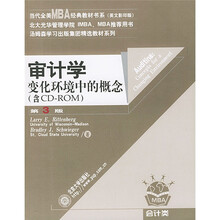审计学变化环境中的概念(第3版)(英文影印版)(附光盘)

Chapter 1: Assurance Services
Introduction
A. Need for Assurance
Potential Bias in Providing Information
Remoteness of Users
Complexity
Need for Assurance Regarding Information and Operations
B. The Special Role of Financial Statement Audits
Auditing Defined
The Need for Unbiased Reporting
Requirements to Enter the Public Accounting Profession
C. The Providers of Assurance Services
The Public Accounting Profession
The Internal Audit Profession
Governmental Auditing Profession
D. Other Professional and Regulatory Organizations
The American Institute of Certified Public Accountants
State Boards of Accountancy
The Securities and Exchange Commission
The Institute of Internal Auditors
The U.S. General Accounting Office
The Court System
Summary
Significant Terms
eview Questions
Multiple-Choice Questions
Discussion and Research Questions
Cases
Chapter 2: Corporate Governance, Serving Client and Public Interests, and Audit Professionalism
A. Corporate Governance: Serving Client and Public Interests
Roles of Interested Parties
Who Is the Audit Client?
Audit Committees
Serving the Publics Interests
Assuring Quality
Framework for Quality
B. Maintaining Professionalism: Standards
Need for Professional Standards
Generally Accepted Auditing Standards
Standards for Other Audit Engagements
C. Maintaining Professionalism: Ethical Framework
Importance of Ethical Conduct
AICPA Code of Professional Conduct
Ethical Theories: Resolving Issues That Are Not Black or White 60 An Ethical Framework
D. Maintaining Professionalism: Ensuring Quality
Quality Control Standards and External Peer Reviews
Internal Peer Review Programs
Summary
Significant Terms
Review Questions
Multiple-Choice Questions
Discussion and Research Questions
Cases
Chapter 3: The Audit Process
A. Overview of Audit Process
Developing an Understanding with the Client
The Audit Process
B. Materiality and Audit Risk
Overall Materiality versus Individual Account Materiality
Materiality Approaches
Risk of Material Misstatement
Risk Concepts
The Professions Audit Risk Model: Practice Implications
Illustration of the Audit Risk Model
Limitations of the Audit Risk Model
C. Management Assertions
Financial Statement Assertions
Assertions for Other Assurance Services
D. Audit Evidence and Procedures
Relevance
Persuasiveness
Sufficiency
Relationship Among Audit Procedures and Assertions
Examples of Audit Programs
Summary
Significant Terms
Review Questions
Multiple-Choice Questions
Discussion and Research Questions
Chapter 4: Understanding Business Risk: A Framework for Audit Planning
Chapter 5: Evaluating the Integrity and Effectiveness of the Clients Control Systems
Chapter 6: Computer-Based Processing: Developing an Audit Assessment Approach
Chapter 7: Direct Tests of Account Balances
Chapter 8: Auditing Computerized Information Systems
A. Computer Audit Took to Test Computer Processing
Overview of a Comprehensive Approach to Computerized Data Processing
Introduction
A. Need for Assurance
Potential Bias in Providing Information
Remoteness of Users
Complexity
Need for Assurance Regarding Information and Operations
B. The Special Role of Financial Statement Audits
Auditing Defined
The Need for Unbiased Reporting
Requirements to Enter the Public Accounting Profession
C. The Providers of Assurance Services
The Public Accounting Profession
The Internal Audit Profession
Governmental Auditing Profession
D. Other Professional and Regulatory Organizations
The American Institute of Certified Public Accountants
State Boards of Accountancy
The Securities and Exchange Commission
The Institute of Internal Auditors
The U.S. General Accounting Office
The Court System
Summary
Significant Terms
eview Questions
Multiple-Choice Questions
Discussion and Research Questions
Cases
Chapter 2: Corporate Governance, Serving Client and Public Interests, and Audit Professionalism
A. Corporate Governance: Serving Client and Public Interests
Roles of Interested Parties
Who Is the Audit Client?
Audit Committees
Serving the Publics Interests
Assuring Quality
Framework for Quality
B. Maintaining Professionalism: Standards
Need for Professional Standards
Generally Accepted Auditing Standards
Standards for Other Audit Engagements
C. Maintaining Professionalism: Ethical Framework
Importance of Ethical Conduct
AICPA Code of Professional Conduct
Ethical Theories: Resolving Issues That Are Not Black or White 60 An Ethical Framework
D. Maintaining Professionalism: Ensuring Quality
Quality Control Standards and External Peer Reviews
Internal Peer Review Programs
Summary
Significant Terms
Review Questions
Multiple-Choice Questions
Discussion and Research Questions
Cases
Chapter 3: The Audit Process
A. Overview of Audit Process
Developing an Understanding with the Client
The Audit Process
B. Materiality and Audit Risk
Overall Materiality versus Individual Account Materiality
Materiality Approaches
Risk of Material Misstatement
Risk Concepts
The Professions Audit Risk Model: Practice Implications
Illustration of the Audit Risk Model
Limitations of the Audit Risk Model
C. Management Assertions
Financial Statement Assertions
Assertions for Other Assurance Services
D. Audit Evidence and Procedures
Relevance
Persuasiveness
Sufficiency
Relationship Among Audit Procedures and Assertions
Examples of Audit Programs
Summary
Significant Terms
Review Questions
Multiple-Choice Questions
Discussion and Research Questions
Chapter 4: Understanding Business Risk: A Framework for Audit Planning
Chapter 5: Evaluating the Integrity and Effectiveness of the Clients Control Systems
Chapter 6: Computer-Based Processing: Developing an Audit Assessment Approach
Chapter 7: Direct Tests of Account Balances
Chapter 8: Auditing Computerized Information Systems
A. Computer Audit Took to Test Computer Processing
Overview of a Comprehensive Approach to Computerized Data Processing
Karrt E.Rittenberg博士是美国University of Wisconsin-Madison会计和信息系统的Ernst & Young 教材,讲授审计、计算机和业务审计。他曾经是内部审计师协会业务部的副主席和内部审计师研究基金的主席;美国会计学协会审计标准委员会的委员;美国会计师协会下属计算机审计委员会、信息技术委员会的委员,审计委员会的蓝带委员。他现在担任美国会计学协会的副主席和财力员。Rittenberg教授是注册会计师、计算机工业协会会员和注册内部审计师。他是5本课本和专著的联合作者并发表过大量文章。
Bradley J.schwieger,工商管理博士和注册会计师,ST.Cloud state university 的商务和会计系教授,美国会计学协会、美国会计师协会和明尼苏达注册会计量的审计成员。
Bradley J.schwieger,工商管理博士和注册会计师,ST.Cloud state university 的商务和会计系教授,美国会计学协会、美国会计师协会和明尼苏达注册会计量的审计成员。
本版更为强调的是理解商业风险和新的商业环境。本书把在商业环境中发生的主要变化全部组织在一起,以现实中各种趋势的发展作为第三版的编著基础。本版继续强调现实世界练习,其中包括利用网络的有意义的商业风险练习和现实世界的计算机化的练习。本书包含全世界使用最为广泛的审计软件包IDEA,由CaseWare国际公司授权。IDEA提供给学生快速的学习经验和竞争优势。
适用对象:适用于审计学初级课程。
适用对象:适用于审计学初级课程。
比价列表
公众号、微信群
 缺书网
缺书网微信公众号
 扫码进群
扫码进群实时获取购书优惠





